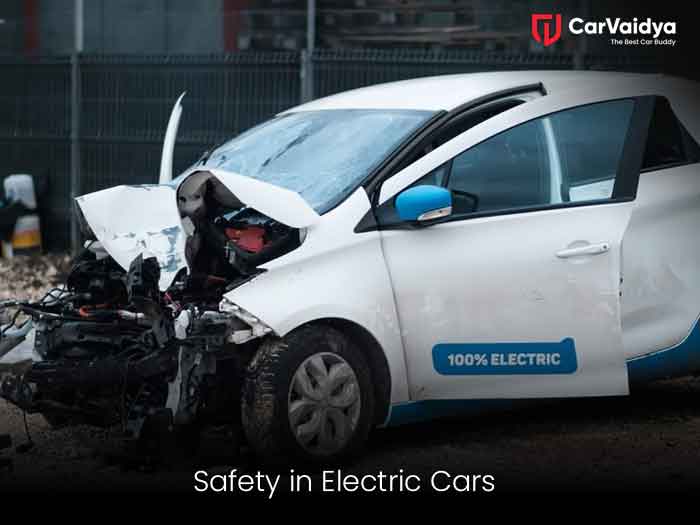Ensuring Safety in Electric Cars


 By CarVaidya
By CarVaidyaThe advent of electric vehicles (EVs) has revolutionized the automotive industry, offering eco-friendly alternatives to traditional petrol and diesel based cars. Alongside their environmental benefits, EVs also raise safety questions, particularly during travel. Servicing electric cars is also an important perspective for EV security & safety. In this article, we will share the safety features of electric cars and explore potential risks that may arise during journeys, providing comprehensive insights for both current and prospective EV owners.
Electric cars are equipped with various safety features designed to mitigate risks and ensure passenger protection. These features include
Battery Safety: The battery pack, a crucial component of electric vehicles, undergoes rigorous testing to withstand impacts and prevent thermal runaway, which could lead to fires or explosions. Battery management systems continuously monitor temperature and voltage levels to prevent overheating or overcharging.
Structural Integrity: Electric cars often incorporate robust structural designs to enhance crashworthiness. Materials such as aluminum and carbon fiber contribute to lightweight yet durable vehicle frames, reducing the impact of collisions and enhancing overall safety.
Advanced Driver Assistance Systems (ADAS): ADAS technologies, including adaptive cruise control, lane-keeping assist, and automatic emergency braking, provide additional layers of safety by assisting drivers in avoiding accidents and mitigating risks on the road.
Regenerative Braking: Electric cars utilize regenerative braking systems, which not only improve energy efficiency but also enhance braking performance and control. This feature contributes to safer driving experiences by reducing the risk of skidding or loss of control.
Low Center of Gravity: Electric vehicles typically have a lower center of gravity due to the placement of heavy battery packs beneath the cabin floor. This characteristic enhances stability and reduces the likelihood of rollover accidents, particularly in high-speed maneuvers.
Enhanced Pedestrian Safety: Electric cars often incorporate pedestrian detection systems and external sound generators to alert pedestrians of their presence, mitigating the risk of collisions in urban environments.
Despite the comprehensive safety features integrated into electric cars, certain challenges and risks persist, particularly during travel
Range Anxiety: Range anxiety refers to the fear of running out of battery power before reaching a charging station. While EVs have made significant advancements in battery technology, long-distance travel may still necessitate careful planning and consideration of charging infrastructure availability.
Charging Infrastructure: The availability and accessibility of charging infrastructure remain a concern for EV owners, especially in remote or rural areas where charging stations may be limited. Inadequate infrastructure can lead to inconvenience and potential delays during travel.
Battery Degradation: Over time, lithium-ion batteries undergo gradual degradation, resulting in reduced range and performance. Factors such as temperature extremes and frequent fast charging can accelerate this degradation process, affecting long-term reliability and potentially impacting travel plans.
Emergency Situations: In the event of a roadside emergency or breakdown, electric vehicle owners may face unique challenges, including limited access to charging facilities and specialized towing services equipped to handle EVs. Adequate preparation and knowledge of emergency procedures are essential for addressing such situations effectively.
Environmental Conditions: Extreme weather conditions, such as extreme heat or cold, can affect the performance and efficiency of electric cars, leading to range limitations and potential safety concerns. Precautionary measures, such as pre-conditioning the cabin temperature and conserving energy during adverse conditions, can help mitigate these risks.
To ensure safe and enjoyable travel experiences in electric cars, consider the following precautions
Plan Your Route: Before embarking on a journey, plan your route carefully, taking into account the availability of charging stations and potential rest stops along the way. Utilize online resources and smartphone apps to identify charging locations and estimate charging times accurately.
Monitor Battery Health: Keep track of your vehicle's battery health and range through the onboard display or mobile applications provided by the manufacturer. Avoid consistently charging the battery to its maximum capacity or discharging it below recommended levels to prolong its lifespan and maintain optimal performance.
Carry Emergency Supplies: Prepare an emergency kit containing essential items such as a flashlight, first-aid supplies, blankets, and emergency contact information. Additionally, consider carrying a portable charger or jumper cables compatible with electric vehicles in case of battery-related issues.
Stay Informed: Stay informed about software updates, recalls, and maintenance recommendations issued by the vehicle manufacturer. Regularly check for updates to ensure your vehicle's systems are operating efficiently and address any potential safety concerns promptly.
Drive Responsibly: Practice safe driving habits, including adhering to speed limits, maintaining a safe following distance, and avoiding distractions while driving. Familiarize yourself with the unique characteristics of electric vehicles, such as regenerative braking and instant torque, to optimize driving performance and efficiency.
Electric cars offer a compelling blend of sustainability, performance, and safety, making them an attractive option for environmentally conscious consumers. By understanding the safety features, challenges, and precautions associated with electric vehicle travel, owners can maximize their driving experience while minimizing potential risks. With ongoing advancements in technology and infrastructure, the future of electric mobility promises even greater convenience, reliability, and safety on the road.
Reasons behind Car Engine Overheating Tips & Precautions
The Significance of Vehicle Registrations Plate Colors
Three Add – On Covers to Consider With Car Insurance


0 Comments